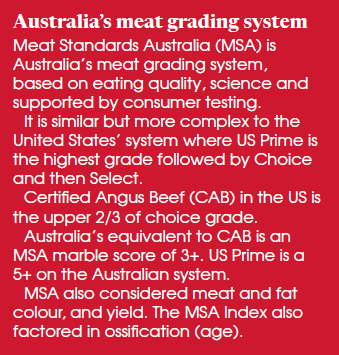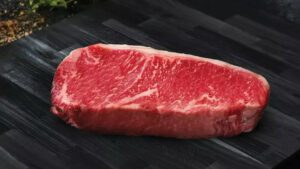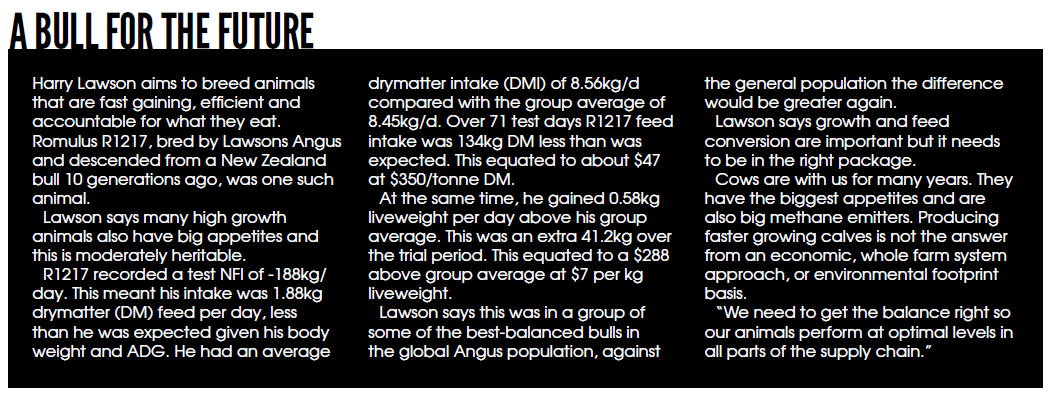Passing the taste test
Meat quality under sustainable and regenerative farming systems are subject of study in New Zealand, with a focus on marbling. Jo Cuttance reports.

Meat quality under sustainable and regenerative farming systems are subject of study in New Zealand, with a focus on marbling. Jo Cuttance reports.
The Impact of regenerative farming on meat quality observational study gathered data on whether meat quality differs between regenerative and sustainable (conventional) farms, and its relationship to botanical diversity.
AgFirst agricultural consultant Steve Howarth commented in the study, that studies from overseas had shown cattle finished on diverse mountain pastures, with nearly 40 species, had improved meat quality and taste compared to pastures on the flats with few species.
The observational study found some higher marbling in a regenerative system, though not statistically significant.
Lawsons Angus (Australia) managing director Harry Lawson has spent decades researching and improving the meat quality of his stock and says there are many confounding factors in terms of meat quality claims. It was good someone was doing a proper study.
Key factors in marbling expression are genetics and diet, with other influences being age or maturity, rumen development at weaning, lifetime nutrition, and animal health, Lawson says.

Starch is a big factor in expressing marbling. Diets high in starch like grain or corn help achieve consistent results. It is harder to achieve in grass-fed systems, but fodder beet, turnips, and some other bulbous brassicas are another source of starch.
In terms of “mountain pastures,” this was where cattle could frolic in the hills under low stocking pressure. Often as plants matured and seeded this could provide a source of starch which would help express marbling.
Agricultural scientist Jon Hickford questions the efficiency of this system, particularly if animals are two or three year old bullocks or heifers roaming the mountains. Lawson agrees the stock would have massive intakes and consequently their methane outputs and emissions intensity (kilograms methane per kilogram liveweight or carcase weight) would be comparatively high because their maintenance levels would be high, and often, average daily gains were low.
“It’s really only the wealthy with high equity balance sheets and an idealistic approach to farming that can farm this way,” Lawson says.
They seemed to focus on the soil carbon elements of greenhouse gases and ignore that livestock are the methane emitters.
“We really need a whole farm approach,” Lawson says.
Marbling off grass ‘hard to achieve’
Good marbling scores off grass and mountain pastures are possible, but it is very hard to achieve consistently high marbling off grass and to build a supply chain and brand.
In a global food sense, the United States is the market leader for high quality marbling beef, with most of their beef consumed domestically.
Lawson has studied marbling and meat quality from a genetic, production system and consumer perspective for nearly 30 years. He has worked with Gardiner Angus Ranch (GAR) in the US, in terms of genetic improvement for onfarm and carcase traits, since 1994. GAR was involved in a large company called US Premium Beef (USPB).
USPB processed more than 1.2 million high quality cattle a year, and farmers were paid on a grid basis for meat quality and yield.
Lawson had the carcase data for the past 12 months, which had individual grid data for over 3000 head that GAR had processed through USPB.
US Prime carcases were achieving grid premiums of US50c/lb, which in Australian terms was about US$440/head premium on 400kg carcase.
Lawson says GAR is routinely achieving compliance rates of 90% CAB acceptance against an industry average of about 20% and about 40% US Prime.
He saw a massive impact in terms of genetics off grass. This was monitored through Meat Standards Australia (MSA) compliance report. Lawson acknowledges this is not statistically valid genetic trials, but it useful feedback and important financial data.
The top grass-fed brand in Australia is JBS’s Little Joe’s which was a marbling score (MS) 4+. It was named after a game of cards where a Little Joe is rolling two twos, with a probability of about 3%.
Chasing Little Joe

Lawson says hitting the Little Joe’s marble score 4+ and MSA Index 64+ was once regarded as “a feat near impossible to replicate”.
Now they have King Island clients consistently achieving compliance rates of about >20%, over five times the compliance rate compared to industry average of <4%. This equates to $120-$150 per head premium.
Overall, they achieve premiums above the grid on 95% of cattle, and averaging over $50 per head premium above the standard grid price.
Lawson says this is not luck. They had generations of superior carcase traits stacking the odds in their favour!
New Zealand beef genetics lag a long way behind the top end of Australia and the US, he says.
“To achieve the results we are achieving in the feedlot and off grass takes generations of disciplined breeding.”
There is massive variation between animals. Ideal animals are fast growing, with good feed conversion and low Net Feed Intake (NFI).
There could be big gains in NFI over the next 10 years with potential to improve this trait (moderately heritable) by 25-30% and still lead the way with other key multi-traits (calving ease, fertility, cow size, growth in the right package, EMA, marbling and yield).





